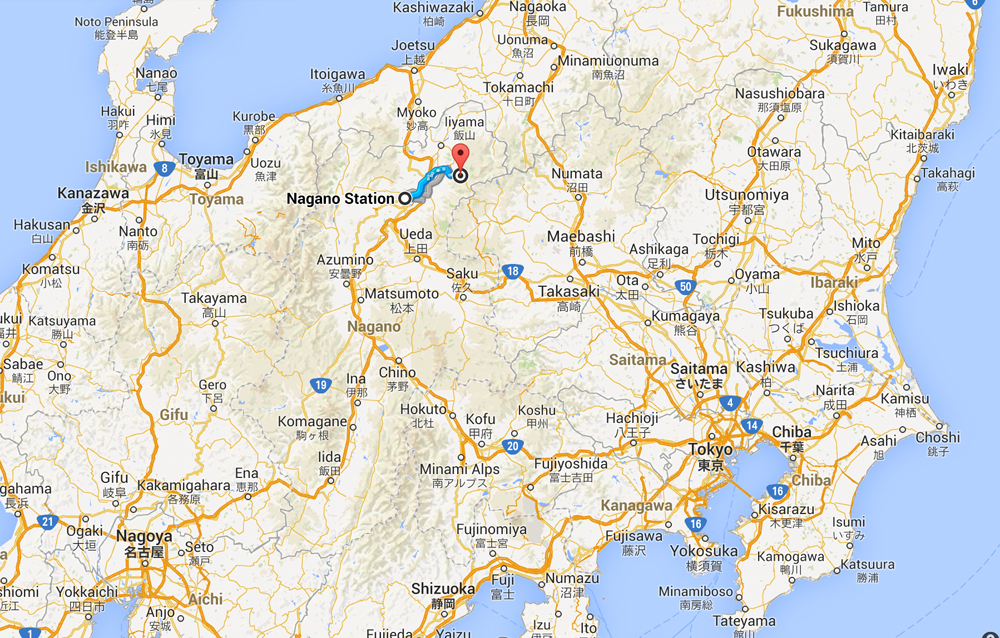Japan’s Snow Monkey Spa and how to get there
Monkeys are pretty cool at the best of times, whilst being admittedly somewhat scary and crazy mini humans, their comedic value and intriguing intelligence (what’s going on behind those beady little eyes?) makes for at least plenty of entertainment.
Some of us may be well used to seeing pictures of friends and family on one of South East Asia’s popular monkey beaches, where tourists gather as part of a day trip stop off to in turn gawp and be gawped at our close relatives whilst trying hard to not have bikinis and board shorts accidentally ripped off by food searching primates.
Africa and South America also have their fair share of primate interaction – a cliché even leading to a near diplomatic incident between Brazil and the United States in 2002 – brought on by The Simpson’s depiction of monkeys in the streets of Rio de Janeiro (season 13, “Blame It on Lisa”). President Fernando Henrique Cardoso and the Rio tourist board threatened to sue the producers for defamation of the city as ‘uncivilised’, but charges were dropped after producer James L. Brooks offered to have Homer fight the Brazilian president on Celebrity Boxing as a form of apology. We like this guy.
So we all know, monkeys = heat and jungle. Try this on for size: a fully-fledged outdoor monkey spa in the frozen snowy mountains of Japan?
Japan is famous for its love of natural hot springs, where the otherwise very private Japanese regularly take all their clothes off to soak collectively in pools of geo-thermally heated, mineral rich waters – all be it gender segregated (we’re not talking Germans here). The practice of going to the Onsen and spending hours in it repeatedly cleansing and soaking whilst warming your body to its core is understandably very popular – especially in said freezing parts of Japan where snow coverage racks up several meters at the side of pristinely cleared roads.
No surprise then that Japan’s Macaques (also known as ‘Snow Monkeys’ because they… well… like ice cream?…) have tagged onto the idea and spend the long snowy winter months with its usual -10 degrees temperatures in the mountains of Nagano Prefecture hanging out in Hell’s Valley – Jigokudani if you want to be all local insider-ish.
The steep valley formed by the Yokoyu river has an abundance of crevices that allow steam and boiling water to bubble up from the depths below which give this somewhat harsh environment its name – no Hells Angel’s hairy bikers here though, except on the occasional Tuesday. The monkeys roam the Joshinetsu Kogen National Park’s forests and seek shelter in them overnight, but if you would like to grab a glimpse of them during the winter day time, here is how it’s done.
From Nagano station, there are several options:
1) There is a one-day Japan Snow Monkey tour from Nagano, arranged by JTB, the rail network that also provides the highly recommendable JR Railpasses. See here for details.
2) There is an Express Bus run by Nagaden from Nagano Station’s East Exit to Kanbayashi (stop “Kanbayashi Onsen Guchi”), which is a little more expensive, but a straightforward way to get to the walking trail that leads up the mountain.
3) There is also the possibility of taking the train to Yudanaka (take the Nagano Dentetsu limited express train) which runs a more frequent service than the busses, however, you need to take a local bus from Yudanaka to the Kanbayashi trailhead (there are also mini shuttle bus services and of course taxis available at a higher price).
4) If you’re a bit minted or in a rush or lazy, you can taxi it all the way from Nagano station to Kanbayashi, where the driver will wait for an hour and take you back to Nagano after. Call 026-282-7777 for reservations.


Once you get to the beginning of the Kanbayashi trail, the real fun starts as you make your way on a tiny, very picturesque mountain trail through the woods (watch out for the occasional park keeper daring to ride this tiny trail on a moped to transport supplies from the village to the monkey park entrance hut). On the 30-minute walk up the valley, you can learn little bits and pieces about the monkeys and their natural habitat, whilst enjoying the beautiful setting and solitude of the forest.
Make sure to arrive well in time as the park closes at 5pm when the monkeys head up to the woods for the night. Leave enough time to not have to run up the hill and also to be able to get some good photo or nature spotting time with the monkeys at the spring. And remember, this is not a zoo, so whilst they are there most of the time, on certain days, the monkeys might not be bathing. We are told to avoid days that Man United games are on telly as the monkeys are rumoured to be fervent supporters.
Once you arrive at the guesthouse and human Onsen (interestingly situated DOWN stream from the monkeys – we’re sure they must have their own private spring), make your way to the right up the hill to the park entrance hut, pay your entry fee and walk the short 5 minute stretch across the bridge to the heart of the action – a 10m x 5m pool of hot steaming, monkey teabag smelling Onsen goodness.
For those of you who have watched the Daniel Craig narrated feature length version of Planet Earth “One Life” and marvelled at the wildlife photographer’s closeups of all sorts of incredible beings, including Snow Monkeys – now is your chance. You can step right up to the pool full of fuzzy spa goers, get your camera out right next to them and start snapping away. One word of warning – if you position yourself at the edge of the pool, beware that you will almost certainly have monkey butt thrust in your face at some stage when one of the teenagers starts to assert his imagined territory by walking all over your camera gripping hands.
Having said that, Jigokudani’s monkeys are relatively well behaved – undoubtedly due to the National Park’s highly disciplined keepers, who are very careful to avoid any suggestion of food from the tourists. Whereas monkeys in Thailand and Gibraltar will pounce on your backpack and tear your plastic bags apart in search of a cheeky snack, Japan’s politeness and strict rule abiding seems to have ensured that Jigokudani’s macaques have remained relatively unspoiled and still act very closely to their natural behaviour. Remember they are wild animals and work with the staff to keep it that way.
Japan’s natural beauty is staggering, and having been able to witness such a clash of concepts (jungle vs snow) and amazing creatures (nearly the northern most monkeys in the world with the northern most only 500km away on Honshu Island, Japan, which is a lot harder to get to) was a true privilege. Plus they are darn cute and hilarious. The ease of access to Joshinetsu Kogen National Park and yet lack of overcrowding makes for a truly magical experience we simply had to share with you.
Let us know if you make it to Jigokudani, we would love to see your pictures! Wanna see what it looks like in advance? Check out our Snow Monkey Spa Place Cake now:
